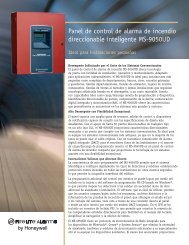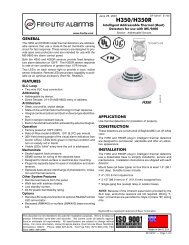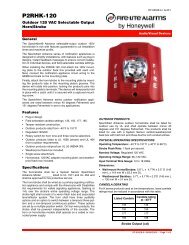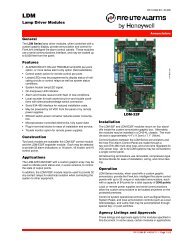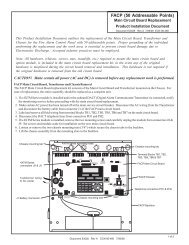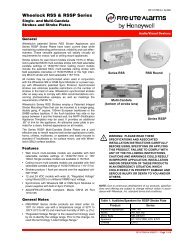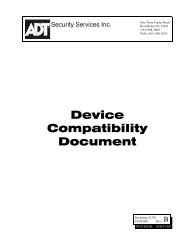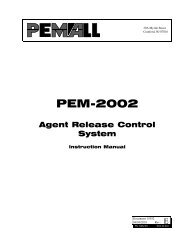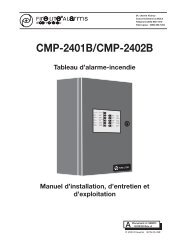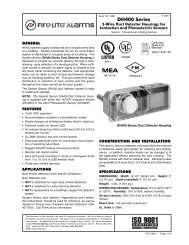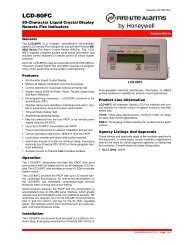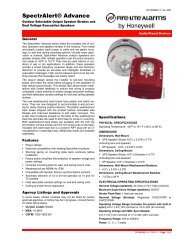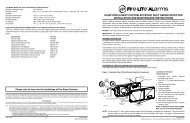ADT-APS-6R Auxiliary Power Supply - Fire-Lite Alarms
ADT-APS-6R Auxiliary Power Supply - Fire-Lite Alarms
ADT-APS-6R Auxiliary Power Supply - Fire-Lite Alarms
Create successful ePaper yourself
Turn your PDF publications into a flip-book with our unique Google optimized e-Paper software.
<strong>ADT</strong><strong>APS</strong>-<strong>6R</strong>__INSTENGLB0.fm Page 1 Tuesday, November 21, 2000 11:30 AM<br />
<strong>ADT</strong>-<strong>APS</strong>-<strong>6R</strong> <strong>Auxiliary</strong> <strong>Power</strong> <strong>Supply</strong><br />
Installation Instructions<br />
<strong>ADT</strong> Security Services, Inc.<br />
1750 Clint Moore Road<br />
Boca Raton, FL 33431<br />
(561) 988-3600<br />
Document 50935<br />
07/21/2000 Revision:B<br />
PN 50935:B ECN 00-317
<strong>Fire</strong> Alarm System Limitations<br />
An automatic fire alarm system–typically made up of<br />
smoke detectors, heat detectors, manual pull stations,<br />
audible warning devices, and a fire alarm control with<br />
remote notification capability–can provide early warning<br />
of a developing fire. Such a system, however, does not<br />
assure protection against property damage or loss of life<br />
resulting from a fire.<br />
The Manufacturer recommends that smoke and/or heat<br />
detectors be located throughout a protected premise<br />
following the recommendations of the current edition of<br />
the National <strong>Fire</strong> Protection Association Standard 72<br />
(NFPA 72), manufacturer's recommendations, State and<br />
local codes, and the recommendations contained in the<br />
Guide for Proper Use of System Smoke Detectors, which<br />
is made available at no charge to all installing dealers.<br />
A study by the Federal Emergency Management Agency<br />
(an agency of the United States government) indicated<br />
that smoke detectors may not go off in as many as 35%<br />
of all fires. While fire alarm systems are designed to<br />
provide early warning against fire, they do not guarantee<br />
warning or protection against fire. A fire alarm system<br />
may not provide timely or adequate warning, or simply<br />
may not function, for a variety of reasons:<br />
Smoke detectors may not sense fire where smoke<br />
cannot reach the detectors such as in chimneys, in or<br />
behind walls, on roofs, or on the other side of closed<br />
doors. Smoke detectors also may not sense a fire on<br />
another level or floor of a building. A second-floor<br />
detector, for example, may not sense a first-floor or<br />
basement fire.<br />
Particles of combustion or "smoke" from a developing<br />
fire may not reach the sensing chambers of smoke<br />
detectors because:<br />
Barriers such as closed or partially closed doors,<br />
walls, or chimneys may inhibit particle or smoke flow.<br />
Smoke particles may become "cold," stratify, and not<br />
reach the ceiling or upper walls where detectors are<br />
located.<br />
Smoke particles may be blown away from detectors<br />
by air outlets.<br />
Smoke detectors may be drawn into air returns before<br />
reaching the detector.<br />
The amount of "smoke" present may be insufficient to<br />
alarm smoke detectors. Smoke detectors are designed<br />
to alarm at various levels of smoke density. If such<br />
density levels are not created by a developing fire at the<br />
location of detectors, the detectors will not go into alarm.<br />
Smoke detectors, even when working properly, have<br />
sensing limitations. Detectors that have photoelectronic<br />
sensing chambers tend to detect smoldering fires better<br />
than flaming fires, which have little visible smoke.<br />
Detectors that have ionizing-type sensing chambers<br />
tend to detect fast-flaming fires better than smoldering<br />
fires. Because fires develop in different ways and are<br />
often unpredictable in their growth, neither type of detector<br />
is necessarily best and a given type of detector may<br />
not provide adequate warning of a fire.<br />
Smoke detectors cannot be expected to provide<br />
adequate warning of fires caused by arson, children<br />
playing with matches (especially in bedrooms), smoking<br />
in bed, and violent explosions (caused by escaping gas,<br />
improper storage of flammable materials, etc.).<br />
LimWarSm.p65 01/10/2000<br />
While a fire alarm system may lower insurance<br />
rates, it is not a substitute for fire insurance!<br />
Heat detectors do not sense particles of combustion and<br />
alarm only when heat on their sensors increases at a<br />
predetermined rate or reaches a predetermined level.<br />
Rate-of-rise heat detectors may be subject to reduced<br />
sensitivity over time. For this reason, the rate-of-rise<br />
feature of each detector should be tested at least once<br />
per year by a qualified fire protection specialist. Heat<br />
detectors are designed to protect property, not life.<br />
IMPORTANT! Smoke detectors must be installed in<br />
the same room as the control panel and in rooms used<br />
by the system for the connection of alarm transmission<br />
wiring, communications, signaling, and/or power. If<br />
detectors are not so located, a developing fire may damage<br />
the alarm system, crippling its ability to report a fire.<br />
Audible warning devices such as bells may not alert<br />
people if these devices are located on the other side of<br />
closed or partly open doors or are located on another<br />
floor of a building. Any warning device may fail to alert<br />
people with a disability or those who have recently consumed<br />
drugs, alcohol or medication. Please note that:<br />
Strobes can, under certain circumstances, cause<br />
seizures in people with conditions such as epilepsy.<br />
Studies have shown that certain people, even when<br />
they hear a fire alarm signal, do not respond or<br />
comprehend the meaning of the signal. It is the<br />
property owner's responsibility to conduct fire drills<br />
and other training exercise to make people aware of<br />
fire alarm signals and instruct them on the proper<br />
reaction to alarm signals.<br />
In rare instances, the sounding of a warning device<br />
can cause temporary or permanent hearing loss.<br />
A fire alarm system will not operate without any<br />
electrical power. If AC power fails, the system will<br />
operate from standby batteries only for a specified time<br />
and only if the batteries have been properly maintained<br />
and replaced regularly.<br />
Equipment used in the system may not be technically<br />
compatible with the control. It is essential to use only<br />
equipment listed for service with your control panel.<br />
Telephone lines needed to transmit alarm signals from<br />
a premise to a central monitoring station may be out of<br />
service or temporarily disabled. For added protection<br />
against telephone line failure, backup radio transmission<br />
systems are recommended.<br />
The most common cause of fire alarm malfunction is<br />
inadequate maintenance. To keep the entire fire alarm<br />
system in excellent working order, ongoing maintenance<br />
is required per the manufacturer's recommendations,<br />
and UL and NFPA standards. At a minimum, the<br />
requirements of Chapter 7 of NFPA 72 shall be followed.<br />
Environments with large amounts of dust, dirt or high air<br />
velocity require more frequent maintenance. A maintenance<br />
agreement should be arranged through the local<br />
manufacturer's representative. Maintenance should be<br />
scheduled monthly or as required by National and/or<br />
local fire codes and should be performed by authorized<br />
professional fire alarm installers only. Adequate written<br />
records of all inspections should be kept.
Installation Precautions<br />
WARNING - Several different sources of power can be<br />
connected to the fire alarm control panel. Disconnect all<br />
sources of power before servicing. Control unit and<br />
associated equipment may be damaged by removing<br />
and/or inserting cards, modules, or interconnecting<br />
cables while the unit is energized. Do not attempt to<br />
install, service, or operate this unit until this manual is<br />
read and understood.<br />
CAUTION - System Reacceptance Test after Software<br />
Changes. To ensure proper system operation, this<br />
product must be tested in accordance with NFPA 72<br />
Chapter 7 after any programming operation or change in<br />
site-specific software. Reacceptance testing is required<br />
after any change, addition or deletion of system components,<br />
or after any modification, repair or adjustment to<br />
system hardware or wiring.<br />
All components, circuits, system operations, or software<br />
functions known to be affected by a change must be<br />
100% tested. In addition, to ensure that other operations<br />
are not inadvertently affected, at least 10% of initiating<br />
devices that are not directly affected by the change, up<br />
to a maximum of 50 devices, must also be tested and<br />
proper system operation verified.<br />
This system meets NFPA requirements for operation<br />
at 0-49° C/32-120° F and at a relative humidity of 85%<br />
RH (non-condensing) at 30° C/86° F. However, the<br />
useful life of the system's standby batteries and the<br />
electronic components may be adversely affected by<br />
extreme temperature ranges and humidity. Therefore,<br />
it is recommended that this system and all peripherals<br />
be installed in an environment with a nominal room<br />
temperature of 15-27° C/60-80° F.<br />
Verify that wire sizes are adequate for all initiating and<br />
indicating device loops. Most devices cannot tolerate<br />
more than a 10% I.R. drop from the specified device<br />
voltage.<br />
FCC Warning<br />
WARNING: This equipment generates, uses, and<br />
can radiate radio frequency energy and if not installed<br />
and used in accordance with the instruction<br />
manual, may cause interference to radio communications.<br />
It has been tested and found to comply<br />
with the limits for class A computing device pursuant<br />
to Subpart B of Part 15 of FCC Rules, which is<br />
designed to provide reasonable protection against<br />
such interference when operated in a commercial<br />
environment. Operation of this equipment in a<br />
residential area is likely to cause interference, in<br />
which case the user will be required to correct the<br />
interference at his own expense.<br />
Adherence to the following will aid in problem-free<br />
installation with long-term reliability:<br />
Like all solid state electronic devices, this system may<br />
operate erratically or can be damaged when subjected<br />
to lightning-induced transients. Although no system is<br />
completely immune from lightning transients and interferences,<br />
proper grounding will reduce susceptibility.<br />
Overhead or outside aerial wiring is not recommended,<br />
due to an increased susceptibility to nearby lightning<br />
strikes. Consult with the Technical Services Department<br />
if any problems are anticipated or encountered.<br />
Disconnect AC power and batteries prior to removing<br />
or inserting circuit boards. Failure to do so can damage<br />
circuits.<br />
Remove all electronic assemblies prior to any drilling,<br />
filing, reaming, or punching of the enclosure. When<br />
possible, make all cable entries from the sides or rear.<br />
Before making modifications, verify that they will not<br />
interfere with battery, transformer, and printed circuit<br />
board location.<br />
Do not tighten screw terminals more than 9 in-lbs.<br />
Over-tightening may damage threads, resulting in<br />
reduced terminal contact pressure and difficulty with<br />
screw terminal removal.<br />
Though designed to last many years, system components<br />
can fail at any time. This system contains staticsensitive<br />
components. Always ground yourself with a<br />
proper wrist strap before handling any circuits so that<br />
static charges are removed from the body. Use staticsuppressive<br />
packaging to protect electronic assemblies<br />
removed from the unit.<br />
Follow the instructions in the installation, operating,<br />
and programming manuals. These instructions must<br />
be followed to avoid damage to the control panel and<br />
associated equipment. FACP operation and reliability<br />
depend upon proper installation by authorized personnel.<br />
Canadian Requirements<br />
This digital apparatus does not exceed the<br />
Class A limits for radiation noise emissions from<br />
digital apparatus set out in the Radio Interference<br />
Regulations of the Canadian Department<br />
of Communications.<br />
Le present appareil numerique n'emet pas de<br />
bruits radioelectriques depassant les limites<br />
applicables aux appareils numeriques de la<br />
classe A prescrites dans le Reglement sur le<br />
brouillage radioelectrique edicte par le<br />
ministere des Communications du Canada.<br />
LimWarSm.p65 01/10/2000
<strong>ADT</strong><strong>APS</strong>-<strong>6R</strong>__INSTENGLB0TOC.fm Page 4 Tuesday, November 21, 2000 12:56 PM<br />
Table of Contents<br />
1. Overview<br />
2. Installation<br />
Table of Contents<br />
Introduction ..................................................................................................... 5<br />
Description ....................................................................................................... 5<br />
Specifications ................................................................................................... 7<br />
Introduction ..................................................................................................... 9<br />
Mounting an <strong>ADT</strong>-<strong>APS</strong>-<strong>6R</strong> in a <strong>ADT</strong>-CAB-400AA Backbox................... 10<br />
Mounting in <strong>ADT</strong>-CAB-3 Series Cabinets..................................................11<br />
Instructions for mounting: .........................................................................11<br />
CHS-4 Series Chassis Mounting................................................................ 11<br />
Wiring the <strong>ADT</strong>-<strong>APS</strong>-<strong>6R</strong>.............................................................................. 12<br />
Field Wiring an <strong>ADT</strong>-<strong>APS</strong>-<strong>6R</strong> .................................................................. 12<br />
Connecting Multiple <strong>ADT</strong>-<strong>APS</strong>-<strong>6R</strong> <strong>Power</strong> Supplies ................................ 13<br />
Wiring Applications ...................................................................................... 14<br />
Connecting the <strong>ADT</strong>-<strong>APS</strong>-<strong>6R</strong> to an ICM-4/ICE-4 Module ...................... 14<br />
<strong>Supply</strong>ing <strong>Power</strong> to a M300C<strong>ADT</strong> Module .............................................. 15<br />
Configuring the <strong>ADT</strong>-<strong>APS</strong>-<strong>6R</strong> ..................................................................... 16<br />
Servicing the <strong>ADT</strong>-<strong>APS</strong>-<strong>6R</strong> .......................................................................... 17<br />
Appendix A - Unimode 4-16<br />
Connecting the <strong>ADT</strong>-<strong>APS</strong>-<strong>6R</strong> to an MPS-24B............................................19<br />
Appendix B - Unimode 300/400<br />
Connecting the <strong>ADT</strong>-<strong>APS</strong>-<strong>6R</strong> to an MPS-400 ............................................21<br />
Appendix C - Unimode II & Unimode 2020<br />
Connecting the <strong>ADT</strong>-<strong>APS</strong>-<strong>6R</strong> to an MPS-24A ........................................... 23<br />
Connecting the <strong>ADT</strong>-<strong>APS</strong>-<strong>6R</strong> to an MPS-24B............................................24<br />
4 <strong>ADT</strong>-<strong>APS</strong>-<strong>6R</strong> Installation PN 50935:B 7/21/00
<strong>ADT</strong><strong>APS</strong>-<strong>6R</strong>__INSTENGLB0.fm Page 5 Tuesday, November 21, 2000 11:30 AM<br />
Introduction<br />
Description<br />
1. Overview<br />
This document contains information for installing, servicing, and<br />
configuring the <strong>ADT</strong>-<strong>APS</strong>-<strong>6R</strong> <strong>Auxiliary</strong> <strong>Power</strong> <strong>Supply</strong>. The table below<br />
contains a list of document sources for supplemental information:<br />
Control Panels Refer to... Part Number<br />
Unimode 4-16 Unimode 4-16 Installation<br />
Manual<br />
A15019<br />
Unimode II Series Unimode II Installation<br />
Manual<br />
A15583<br />
Unimode 400 Series Unimode 400 Installation<br />
Manual<br />
50710<br />
Unimode 2020 Unimode 2020 Installation<br />
Manual<br />
51167<br />
<strong>ADT</strong> Transponder<br />
Series<br />
<strong>ADT</strong> Transponder Manual 50928<br />
All <strong>ADT</strong> Device Compatibility<br />
Document<br />
51352<br />
Table 1 Supplemental Documentation<br />
The <strong>ADT</strong>-<strong>APS</strong>-<strong>6R</strong> <strong>Auxiliary</strong> <strong>Power</strong> <strong>Supply</strong> is a 150W cabinet-mounted<br />
power supply, designed to power devices that require filtered, regulated,<br />
non-resettable power, such as XP Transponder modules, Notification<br />
Appliance Circuit Modules and Control Modules. The <strong>ADT</strong>-<strong>APS</strong>-<strong>6R</strong><br />
provides three 24 VDC (filtered) output circuits.<br />
Figure 1 <strong>ADT</strong>-<strong>APS</strong>-<strong>6R</strong> Auxilliary <strong>Power</strong> <strong>Supply</strong><br />
<strong>ADT</strong>-<strong>APS</strong>-<strong>6R</strong> Instruction PN 50935:B 7/21/00 5<br />
<strong>APS</strong>-<strong>6R</strong>isoview.cdr
<strong>ADT</strong><strong>APS</strong>-<strong>6R</strong>__INSTENGLB0.fm Page 6 Tuesday, November 21, 2000 11:30 AM<br />
1. Overview Description<br />
The figures below identify the features of the <strong>ADT</strong>-<strong>APS</strong>-<strong>6R</strong> power<br />
supply:<br />
Three 24 VDC output circuits<br />
Two (2) power-limited<br />
One (1) non power-limited<br />
J1<br />
J9<br />
J2<br />
TB2<br />
Fuse F2 for battery protection<br />
(10A, 3AG, slow blow)<br />
Fuse F1 for AC protection<br />
(4A, 3AG, slow blow)<br />
J3<br />
Figure 2 <strong>ADT</strong>-<strong>APS</strong>-<strong>6R</strong> Control Board<br />
Jumper JP1 for selecting AC input voltage<br />
(120 VAC default)<br />
Trouble In (J4) - Trouble Out (J3)<br />
“P” style connectors for internal cabinet<br />
connections<br />
LED Status Indicators:<br />
Green LED – Indicates AC power on<br />
Yellow LED – Indicates loss of AC or battery<br />
Figure 3 <strong>ADT</strong>-<strong>APS</strong>-<strong>6R</strong> Main Board<br />
6 <strong>ADT</strong>-<strong>APS</strong>-<strong>6R</strong> Instruction PN 50935:B 7/21/00<br />
JP3<br />
JP2<br />
<strong>APS</strong>-<strong>6R</strong>sidebrd.cdr<br />
Jumpers JP2 and JP3 for<br />
selecting 8-hour or 16-hour<br />
delay for AC loss reporting<br />
(default is immediate)<br />
JP1<br />
<strong>APS</strong>-<strong>6R</strong>board.cdr
<strong>ADT</strong><strong>APS</strong>-<strong>6R</strong>__INSTENGLB0.fm Page 7 Tuesday, November 21, 2000 11:30 AM<br />
Specifications 1. Overview<br />
Specifications<br />
The <strong>ADT</strong>-<strong>APS</strong>-<strong>6R</strong> is compatible with the Unimode II, Unimode 300/400,<br />
Unimode 4-16 and Unimode 2020 control panels. Specifications for the<br />
<strong>ADT</strong>-<strong>APS</strong>-<strong>6R</strong> are:<br />
Electrical Specifications<br />
AC Primary Input <strong>Power</strong><br />
Wire Size: #14 AWG with<br />
600 VAC insulation<br />
24 VDC Secondary Input <strong>Power</strong><br />
(lead-acid batteries only)<br />
120 VAC, 60 Hz, 2.5 A<br />
240 VAC, 50 Hz, 1.2 A<br />
25 mA DC standby current<br />
16 mA DC standby current (with AC fail delay<br />
operating)<br />
Note: Batteries are charged by the system power supply.<br />
24 VDC output power<br />
Circuit 1<br />
Circuit 2<br />
Circuit 3<br />
Fuses<br />
F1 (AC supervision)<br />
F2 (battery supervision)<br />
Trouble supervision bus<br />
J3 output<br />
J4 input<br />
Note: J3 and J4 can be<br />
interchanged.<br />
Total 6 A (4 A continuous)<br />
3 A @24 VDC power-limited (+10, –15%)<br />
3 A @24 VDC power-limited (+10, –15%)<br />
6 A @24 VDC non power-limited (+10, –15%)<br />
250 VAC, 4A, 3 AG, slow blow<br />
32 VAC, 10 A, 3 AG, slow blow<br />
Form A contact (open collector)<br />
Form A contact (open collector)<br />
Loss of AC Indication Immediate indication (default)<br />
8 or 16 hour delay<br />
Mechanical Specifications<br />
Size of <strong>ADT</strong>-<strong>APS</strong>-<strong>6R</strong> in enclosure 6.09 in. x 4.23 in. x 2.92 in.<br />
Cabinets for mounting <strong>ADT</strong>-CAB-3 Series, using CHS-4 and CHS-4L<br />
chassis, for Unimode 400, unimode II and<br />
Unimode 2020 control panels.<br />
<strong>ADT</strong>-CAB-400AA for Unimode 300/400<br />
control panel; accepts one <strong>APS</strong>-<strong>6R</strong>.<br />
Unimode 4-16 can accept one <strong>ADT</strong>-<strong>APS</strong>-<strong>6R</strong>.<br />
Note: An optional module (such as an ICM-4) without an expansion card can<br />
mount above an <strong>ADT</strong>-<strong>APS</strong>-<strong>6R</strong> in a CHS-4, a Unimode 4-16, and a<br />
<strong>ADT</strong>-CAB-400AA.<br />
Table 2 <strong>ADT</strong>-<strong>APS</strong>-<strong>6R</strong> Specifications<br />
<strong>ADT</strong>-<strong>APS</strong>-<strong>6R</strong> Instruction PN 50935:B 7/21/00 7
<strong>ADT</strong><strong>APS</strong>-<strong>6R</strong>__INSTENGLB0.fm Page 8 Tuesday, November 21, 2000 11:30 AM<br />
1. Overview Specifications<br />
NOTES<br />
8 <strong>ADT</strong>-<strong>APS</strong>-<strong>6R</strong> Instruction PN 50935:B 7/21/00
<strong>ADT</strong><strong>APS</strong>-<strong>6R</strong>__INSTENGLB0.fm Page 9 Tuesday, November 21, 2000 11:30 AM<br />
!<br />
Introduction<br />
2. Installation<br />
WARNING: Use extreme caution when working with the <strong>APS</strong>-<strong>6R</strong>.<br />
High voltage and AC line-connected circuits are present. Turn off and<br />
remove all power sources. To reduce the risk of electric shock make<br />
sure to properly ground the unit.<br />
This section contains instructions for mounting, wiring, configuring and<br />
servicing the <strong>ADT</strong>-<strong>APS</strong>-<strong>6R</strong>.<br />
Installation topics covered in detail:<br />
Topic Refer to...<br />
Mounting to a <strong>ADT</strong>-CAB-400AA<br />
Backbox<br />
Mounting to a <strong>ADT</strong>-CAB-3 Series<br />
Cabinet<br />
"Mounting an <strong>ADT</strong>-<strong>APS</strong>-<strong>6R</strong> in a<br />
<strong>ADT</strong>-CAB-400AA Backbox" on<br />
page 10<br />
"Mounting in <strong>ADT</strong>-CAB-3 Series<br />
Cabinets" on page 11<br />
Field Wiring "Field Wiring an <strong>ADT</strong>-<strong>APS</strong>-<strong>6R</strong>" on<br />
page 12<br />
Wiring Multiple <strong>ADT</strong>-<strong>APS</strong>-<strong>6R</strong>s "Connecting Multiple <strong>ADT</strong>-<strong>APS</strong>-<strong>6R</strong><br />
<strong>Power</strong> Supplies" on page 13<br />
Connecting to an ICM/ICE "Connecting the <strong>ADT</strong>-<strong>APS</strong>-<strong>6R</strong> to an<br />
ICM-4/ICE-4 Module" on page 14<br />
<strong>Power</strong>ing an M300C<strong>ADT</strong> "<strong>Supply</strong>ing <strong>Power</strong> to a M300C<strong>ADT</strong><br />
Module" on page 15<br />
Configuring "Configuring the <strong>ADT</strong>-<strong>APS</strong>-<strong>6R</strong>" on<br />
page 16<br />
Servicing "Servicing the <strong>ADT</strong>-<strong>APS</strong>-<strong>6R</strong>" on<br />
page 17<br />
<strong>ADT</strong>-<strong>APS</strong>-<strong>6R</strong> Instruction PN 50935:B 7/21/00 9
<strong>ADT</strong><strong>APS</strong>-<strong>6R</strong>__INSTENGLB0.fm Page 10 Tuesday, November 21, 2000 11:30 AM<br />
2. Installation Mounting an <strong>ADT</strong>-<strong>APS</strong>-<strong>6R</strong> in a <strong>ADT</strong>-CAB-400AA Backbox<br />
Mounting an <strong>ADT</strong>-<strong>APS</strong>-<strong>6R</strong> in a <strong>ADT</strong>-CAB-400AA Backbox<br />
An <strong>Auxiliary</strong> <strong>Power</strong> <strong>Supply</strong> is mounted as shown in the figure below.<br />
To mount the <strong>ADT</strong>-<strong>APS</strong>-<strong>6R</strong>, follow these instructions:<br />
Step Action<br />
1 Remove plastic cover from <strong>APS</strong>-<strong>6R</strong>.<br />
2 If 240 VAC is to be used, cut JP1 jumper at this time. See "Configuring the<br />
<strong>ADT</strong>-<strong>APS</strong>-<strong>6R</strong>" on page 16.<br />
3 Place the <strong>APS</strong>-<strong>6R</strong> onto the mounting studs in the backbox.<br />
4 Insert a standoff through each of the printed circuit board mounting holes,<br />
threading each standoff to the mounting studs.<br />
5 Tighten the standoffs until the <strong>APS</strong>-<strong>6R</strong> is securely fastened to the backbox.<br />
6 Reinstall the plastic chassis cover.<br />
<strong>ADT</strong>-<strong>APS</strong>-<strong>6R</strong><br />
Assembly<br />
<strong>ADT</strong>-CAB-400AA<br />
Backbox<br />
Mounting<br />
Studs<br />
Standoff<br />
(2 places)<br />
Figure 4 Mounting an <strong>ADT</strong>-<strong>APS</strong>-<strong>6R</strong> to a <strong>ADT</strong>-CAB-400AA Backbox<br />
10 <strong>ADT</strong>-<strong>APS</strong>-<strong>6R</strong> Instruction PN 50935:B 7/21/00<br />
<strong>APS</strong>-<strong>6R</strong> to CAB-AA.cdr
<strong>ADT</strong><strong>APS</strong>-<strong>6R</strong>__INSTENGLB0.fm Page 11 Tuesday, November 21, 2000 11:30 AM<br />
Mounting in <strong>ADT</strong>-CAB-3 Series Cabinets 2. Installation<br />
Mounting in <strong>ADT</strong>-CAB-3 Series Cabinets<br />
This section contains instructions for the installation of the <strong>Auxiliary</strong><br />
<strong>Power</strong> <strong>Supply</strong> into a <strong>ADT</strong>-CAB-3 Series cabinet (<strong>ADT</strong>-CAB-A3, <strong>ADT</strong>-<br />
CAB-B3, <strong>ADT</strong>-CAB-C3 and <strong>ADT</strong>-CAB-D3).<br />
These cabinets use a CHS-4L or CHS-4 Chassis to mount the<br />
<strong>ADT</strong>-<strong>APS</strong>-<strong>6R</strong>.<br />
Instructions for mounting:<br />
Step Action<br />
1 Remove plastic cover from <strong>APS</strong>-<strong>6R</strong>.<br />
2 If 240 VAC is to be used, cut JP1 jumper at this time. See "Configuring the<br />
<strong>ADT</strong>-<strong>APS</strong>-<strong>6R</strong>" on page 16.<br />
3 Place the <strong>APS</strong>-<strong>6R</strong> onto the mounting studs of the chassis (Figure 5 on page<br />
11).<br />
4 Insert a standoff through each of the printed circuit board mounting holes,<br />
threading each standoff to the mounting studs on the chassis.<br />
5 Tighten the standoffs until the <strong>APS</strong>-<strong>6R</strong> is securely fastened to the chassis.<br />
6 Reinstall the plastic chassis cover.<br />
CHS-4 Series Chassis Mounting<br />
The illustration below shows an <strong>ADT</strong>-<strong>APS</strong>-<strong>6R</strong> being mounted in a CHS-<br />
4L chassis. Mounting in a CHS-4 chassis is accomplished in the same<br />
way.<br />
CHS-4L Chassis<br />
Mounting Studs<br />
Standoff<br />
(2 places)<br />
Figure 5 Mounting an <strong>ADT</strong>-<strong>APS</strong>-<strong>6R</strong> to a CHS-4L Chassis<br />
<strong>ADT</strong>-<strong>APS</strong>-<strong>6R</strong><br />
Assembly<br />
<strong>ADT</strong>-<strong>APS</strong>-<strong>6R</strong> Instruction PN 50935:B 7/21/00 11<br />
<strong>APS</strong>-<strong>6R</strong> to CHS-4L.cdr
<strong>ADT</strong><strong>APS</strong>-<strong>6R</strong>__INSTENGLB0.fm Page 12 Tuesday, November 21, 2000 11:30 AM<br />
2. Installation Wiring the <strong>ADT</strong>-<strong>APS</strong>-<strong>6R</strong><br />
Wiring the <strong>ADT</strong>-<strong>APS</strong>-<strong>6R</strong><br />
!<br />
This section contains instructions for wiring the <strong>Auxiliary</strong> <strong>Power</strong> <strong>Supply</strong><br />
as follows:<br />
Typical field wiring from an <strong>ADT</strong>-<strong>APS</strong>-<strong>6R</strong> to a control panel and<br />
optional devices.<br />
Wiring multiple <strong>ADT</strong>-<strong>APS</strong>-<strong>6R</strong> power supplies.<br />
Field Wiring an <strong>ADT</strong>-<strong>APS</strong>-<strong>6R</strong><br />
You can use J1 and J2 in place of TB2 when the <strong>ADT</strong>-<strong>APS</strong>-<strong>6R</strong> is<br />
powering internal modules (such as an ICM-4, ICE-4, <strong>ADT</strong>-UZC-256,<br />
XPC-8) with compatible connectors.<br />
Output Circuit 3 (J9) can be used as a source of power for the XPIQ Audio<br />
Transponder only.<br />
Note: When using the J9 connector do not use the J2 connector. This will satisfy the<br />
0.25 (6.35mm) requirement for separation between power-limited and nonpowerlimited<br />
circuits.<br />
Primary and Secondary <strong>Power</strong> Connections - See appendix for your<br />
specific system information.<br />
Caution: When finished wiring AC connections, install the press-fit<br />
terminal block cover over TB1 AC connections.<br />
J9<br />
JP2<br />
– + – + – +<br />
JP3<br />
J2<br />
Output Circuit 3: Non <strong>Power</strong>-limited, 6 A @24 VDC (+10, –15%)<br />
TB2<br />
J3<br />
J1<br />
Output Circuit 2 (24 VDC)<br />
Output Circuit 1 (24 VDC)<br />
+<br />
–<br />
+<br />
–<br />
Output Circuit 1: <strong>Power</strong>-limited<br />
3 A @24 VDC (+10, –15%)<br />
Output Circuit 2: <strong>Power</strong>-limited<br />
3 A @24 VDC (+10, –15%)<br />
Trouble Bus In/Out<br />
BATT (+)<br />
BATT (–)<br />
Secondary <strong>Power</strong><br />
24 VDC batteries.<br />
HOT Primary <strong>Power</strong><br />
120 VAC or 240 VAC.<br />
NEUTRAL<br />
Earth Ground - Connects to chassis or<br />
EARTH EARTH ground terminal on main power<br />
supply. If two or more units are connected,<br />
secondary units connect to earthground<br />
on the previous <strong>ADT</strong>-<strong>APS</strong>-<strong>6R</strong> in the chain.<br />
Figure 6 Typical Wiring for an <strong>ADT</strong>-<strong>APS</strong>-<strong>6R</strong><br />
12 <strong>ADT</strong>-<strong>APS</strong>-<strong>6R</strong> Instruction PN 50935:B 7/21/00<br />
<strong>APS</strong>-<strong>6R</strong>sidebrd.cdr
<strong>ADT</strong><strong>APS</strong>-<strong>6R</strong>__INSTENGLB0.fm Page 13 Tuesday, November 21, 2000 11:30 AM<br />
Wiring the <strong>ADT</strong>-<strong>APS</strong>-<strong>6R</strong> 2. Installation<br />
Connecting Multiple <strong>ADT</strong>-<strong>APS</strong>-<strong>6R</strong> <strong>Power</strong> Supplies<br />
Typical trouble bus connections for multiple <strong>ADT</strong>-<strong>APS</strong>-<strong>6R</strong> power<br />
supplies using trouble connectors J3 and J4.<br />
Use Cable 71033 or 75098 (same cables; different lengths) for all wiring.<br />
See appendix on your system for specific “Trouble Input” connection.<br />
Note: J3 and J4 can be interchanged.<br />
J9<br />
To trouble input on main power<br />
supply or control panel<br />
J2<br />
JP2 JP3<br />
TB2<br />
J3<br />
J1<br />
J9<br />
Figure 7 Trouble Bus Connections for Multiple <strong>ADT</strong>-<strong>APS</strong>-<strong>6R</strong> Configurations<br />
<strong>ADT</strong>-<strong>APS</strong>-<strong>6R</strong> Instruction PN 50935:B 7/21/00 13<br />
J2<br />
JP2 JP3<br />
TB2<br />
J3<br />
J1<br />
J9<br />
J2<br />
JP2 JP3<br />
First <strong>APS</strong>-<strong>6R</strong> Last <strong>APS</strong>-<strong>6R</strong><br />
TB2<br />
J3<br />
J1<br />
<strong>APS</strong>-<strong>6R</strong>multiple.cdr
<strong>ADT</strong><strong>APS</strong>-<strong>6R</strong>__INSTENGLB0.fm Page 14 Tuesday, November 21, 2000 11:30 AM<br />
2. Installation Wiring Applications<br />
Wiring Applications<br />
This section contains instructions for wiring the <strong>ADT</strong>-<strong>APS</strong>-<strong>6R</strong> assembly<br />
as follows:<br />
Connecting the <strong>ADT</strong>-<strong>APS</strong>-<strong>6R</strong> to an ICM-4/ICE-4 module<br />
<strong>Supply</strong>ing notification appliance power to a FCM module<br />
Connecting the <strong>ADT</strong>-<strong>APS</strong>-<strong>6R</strong> to an ICM-4/ICE-4 Module<br />
All four (4) NACs on the ICM-4 are powered from the <strong>ADT</strong>-<strong>APS</strong>-<strong>6R</strong><br />
output circuit 2 (J2) and the four (4) NACs on the ICE-4 are powered from<br />
circuit 1 (J1). The NACs share the total 3A available from each circuit.<br />
Typical connections for wiring:<br />
ICM-4<br />
Blue<br />
Black<br />
J5 J6<br />
<strong>ADT</strong>-<strong>APS</strong>-<strong>6R</strong><br />
Blue<br />
Figure 8 Typical <strong>ADT</strong>-<strong>APS</strong>-<strong>6R</strong> Wiring to an ICM-4/ICE-4 Module<br />
14 <strong>ADT</strong>-<strong>APS</strong>-<strong>6R</strong> Instruction PN 50935:B 7/21/00<br />
J5 J6<br />
Black<br />
J9<br />
JP2<br />
JP3<br />
ICE-4<br />
J2<br />
TB2<br />
J3<br />
J1<br />
<strong>Auxiliary</strong> <strong>Power</strong><br />
Harness<br />
PN 71091<br />
<strong>APS</strong>-<strong>6R</strong>icm.cdr
<strong>ADT</strong><strong>APS</strong>-<strong>6R</strong>__INSTENGLB0.fm Page 15 Tuesday, November 21, 2000 11:30 AM<br />
Wiring Applications 2. Installation<br />
J9<br />
JP2<br />
<strong>Supply</strong>ing <strong>Power</strong> to a M300C<strong>ADT</strong> Module<br />
The circuit is supervised and power-limited.<br />
Typical connections for wiring:<br />
JP3<br />
J2<br />
TB2<br />
J3<br />
J1<br />
8<br />
7<br />
6<br />
5<br />
6 7<br />
8 9 5 1011 10<br />
4 11<br />
3<br />
12<br />
2<br />
13<br />
1<br />
0<br />
15<br />
14<br />
TENS<br />
6 7<br />
8 9<br />
5 4 3<br />
2<br />
1<br />
0<br />
ONES<br />
LOOP ADDRESS<br />
NAC<br />
To next device<br />
on SLC loop<br />
Figure 9 Typical <strong>ADT</strong>-<strong>APS</strong>-<strong>6R</strong> Wiring to a M300C<strong>ADT</strong> Module<br />
<strong>ADT</strong>-<strong>APS</strong>-<strong>6R</strong> Instruction PN 50935:B 7/21/00 15<br />
9<br />
0<br />
1<br />
2<br />
3<br />
4<br />
SLC loop<br />
<strong>APS</strong>-<strong>6R</strong>fcm.cdr
<strong>ADT</strong><strong>APS</strong>-<strong>6R</strong>__INSTENGLB0.fm Page 16 Tuesday, November 21, 2000 11:30 AM<br />
2. Installation Configuring the <strong>ADT</strong>-<strong>APS</strong>-<strong>6R</strong><br />
Configuring the <strong>ADT</strong>-<strong>APS</strong>-<strong>6R</strong><br />
The <strong>ADT</strong>-<strong>APS</strong>-<strong>6R</strong> may be configured for the following:<br />
8-hour delay for reporting loss of AC: cut jumper JP2.<br />
16-hour delay for reporting loss of AC: cut jumper JP2 and JP3.<br />
240 VAC operation: cut jumper JP1.<br />
The figure below illustrates the location of the jumpers:<br />
J1<br />
J9<br />
J2<br />
TB2<br />
J3<br />
Figure 10 Configuring the <strong>ADT</strong>-<strong>APS</strong>-<strong>6R</strong><br />
16 <strong>ADT</strong>-<strong>APS</strong>-<strong>6R</strong> Instruction PN 50935:B 7/21/00<br />
JP3<br />
JP1<br />
JP3<br />
JP2<br />
JP2<br />
JP1<br />
<strong>APS</strong>-<strong>6R</strong>config.cdr
<strong>ADT</strong><strong>APS</strong>-<strong>6R</strong>__INSTENGLB0.fm Page 17 Tuesday, November 21, 2000 11:30 AM<br />
Servicing the <strong>ADT</strong>-<strong>APS</strong>-<strong>6R</strong> 2. Installation<br />
Servicing the <strong>ADT</strong>-<strong>APS</strong>-<strong>6R</strong><br />
The only serviceable components on the <strong>ADT</strong>-<strong>APS</strong>-<strong>6R</strong> are fuses F1 and<br />
F2. If a fuse fails, replace it with a fuse of the same type and rating:<br />
F1 AC protection - 4A, 3 AG<br />
F2 Battery protection - 10A, 3 AG<br />
To replace either fuse remove the vertical PC board as follows:<br />
1. Turn off and remove all power sources.<br />
2. Remove plastic cover.<br />
3. Remove the two retaining screws securing vertical board.<br />
4. Unplug the vertical PC board from the connectors.<br />
5. Replace fuses as required.<br />
6. Reinstall board in reverse order, install plastic cover and connect all<br />
power.<br />
The figure below illustrates the location of the fuses.<br />
J1<br />
J9<br />
J2<br />
Retaining Screw (typ)<br />
TB2<br />
J3<br />
Connector (typ)<br />
Main Circuit Board<br />
F2 Fuse<br />
F1 Fuse<br />
Figure 11 Servicing the <strong>ADT</strong>-<strong>APS</strong>-<strong>6R</strong><br />
<strong>ADT</strong>-<strong>APS</strong>-<strong>6R</strong> Instruction PN 50935:B 7/21/00 17<br />
JP3<br />
JP2<br />
<strong>APS</strong>-<strong>6R</strong>service.cdr
<strong>ADT</strong><strong>APS</strong>-<strong>6R</strong>__INSTENGLB0.fm Page 18 Tuesday, November 21, 2000 11:30 AM<br />
2. Installation Servicing the <strong>ADT</strong>-<strong>APS</strong>-<strong>6R</strong><br />
NOTES<br />
18 <strong>ADT</strong>-<strong>APS</strong>-<strong>6R</strong> Instruction PN 50935:B 7/21/00
<strong>ADT</strong><strong>APS</strong>-<strong>6R</strong>__INSTENGLB0.fm Page 19 Tuesday, November 21, 2000 11:30 AM<br />
Appendix A - Unimode 4-16<br />
Connecting the <strong>ADT</strong>-<strong>APS</strong>-<strong>6R</strong> to an MPS-24B<br />
J9<br />
J2<br />
JP2 JP3<br />
TB2<br />
Make the following connections as shown in the figure below.<br />
Connect primary power from TB1 to MPS-24B terminal block<br />
TB1, Pin 3(NEUT) and Pin 4(HOT)<br />
Connect secondary power from TB3 to MPS-24B terminal block<br />
TB3, Pin 1(+) and Pin 2(–)<br />
Connect trouble input from J3 to MPS-24B terminal block P4<br />
J3<br />
J1<br />
CB1<br />
TB1<br />
7P1<br />
5<br />
3<br />
2<br />
1<br />
MPS-24BPCC<br />
REV ___<br />
EARTH AC NEUT AC HOT<br />
R55 1 2 3 4 6 7 8<br />
P2<br />
2 3 4 TB2 1 2 3 4 1 2<br />
Figure 12 Wiring to MPS-24B<br />
+24 VRESET<br />
BATT -<br />
COMMON COMMON +24 VPOWER BATT +<br />
<strong>ADT</strong>-<strong>APS</strong>-<strong>6R</strong> Instruction PN 50935:B 7/21/00 19<br />
JP3<br />
TROUBLES<br />
AC BATT +E F -EF<br />
TB3<br />
P3<br />
P4<br />
<strong>APS</strong>-<strong>6R</strong> to MPS-24B.cdr
<strong>ADT</strong><strong>APS</strong>-<strong>6R</strong>__INSTENGLB0.fm Page 20 Tuesday, November 21, 2000 11:30 AM<br />
Appendix A - Unimode 4-16 Connecting the <strong>ADT</strong>-<strong>APS</strong>-<strong>6R</strong> to an MPS-24B<br />
NOTES<br />
20 <strong>ADT</strong>-<strong>APS</strong>-<strong>6R</strong> Instruction PN 50935:B 7/21/00
<strong>ADT</strong><strong>APS</strong>-<strong>6R</strong>__INSTENGLB0.fm Page 21 Tuesday, November 21, 2000 11:30 AM<br />
Appendix B - Unimode 300/400<br />
Connecting the <strong>ADT</strong>-<strong>APS</strong>-<strong>6R</strong> to an MPS-400<br />
J9<br />
J2<br />
JP2 JP3<br />
TB2<br />
Make the following connections as shown in the figure below.<br />
Connect primary power from TB1 to MPS-400 terminal block TB1<br />
(NEU and HOT)<br />
Connect secondary power from TB3 to MPS-400 terminal block<br />
TB1 (+ and –)<br />
Connect trouble input from J3 to MPS-400 terminal block J4<br />
J3<br />
J1<br />
TB1<br />
NEUTRAL EARTH HOT BATT+ BATT-<br />
To Transform er Assembly T2<br />
To Transformer Assembly T1<br />
J6<br />
RE<br />
WOP<br />
UP<br />
C<br />
J1<br />
S<br />
EI<br />
R<br />
OS<br />
S<br />
E CCA<br />
J2<br />
POWER INPUT- 120V, 60 Hz, and 24 V BATT<br />
R<br />
TO<br />
C<br />
E<br />
N<br />
N<br />
O<br />
C<br />
0<br />
0<br />
4-<br />
P<br />
F A<br />
Figure 13 Wiring to MPS-400<br />
<strong>ADT</strong>-<strong>APS</strong>-<strong>6R</strong> Instruction PN 50935:B 7/21/00 21<br />
T<br />
B<br />
2<br />
+ - + - + -<br />
T<br />
B<br />
3<br />
T<br />
B<br />
4<br />
SUPERVISORY<br />
SE CURITY<br />
5BT<br />
7BT<br />
T<br />
B<br />
6<br />
T<br />
B<br />
8<br />
TB9<br />
B+ B- A+ A- B+ B- A+ A-<br />
JP2 S2<br />
T<br />
B<br />
1<br />
0<br />
S2<br />
<strong>APS</strong>-<strong>6R</strong> to MPS-400.cdr
<strong>ADT</strong><strong>APS</strong>-<strong>6R</strong>__INSTENGLB0.fm Page 22 Tuesday, November 21, 2000 11:30 AM<br />
Appendix B - Unimode 300/400 Connecting the <strong>ADT</strong>-<strong>APS</strong>-<strong>6R</strong> to an MPS-400<br />
NOTES<br />
22 <strong>ADT</strong>-<strong>APS</strong>-<strong>6R</strong> Instruction PN 50935:B 7/21/00
<strong>ADT</strong><strong>APS</strong>-<strong>6R</strong>__INSTENGLB0.fm Page 23 Tuesday, November 21, 2000 11:30 AM<br />
Appendix C - Unimode II & Unimode 2020<br />
Connecting the <strong>ADT</strong>-<strong>APS</strong>-<strong>6R</strong> to an MPS-24A<br />
J9<br />
J2<br />
JP2 JP3<br />
TB2<br />
Make the following connections as shown in the figure below.<br />
Connect primary power from TB1 to MPS-24A terminal block<br />
TB1, Pin 5(NEUT) and Pin 7(HOT)<br />
Connect secondary power from TB3 to MPS-24A terminal block<br />
TB2, Pin 1(+) and Pin 2(–)<br />
Connect trouble input from J3 to MPS-24A terminal block P5<br />
J3<br />
J1<br />
TB1<br />
EA RTH G ND A C NE U TRA L A C HOT<br />
BAT + BAT -<br />
TB2<br />
Figure 14 Wiring to MPS-24A<br />
<strong>ADT</strong>-<strong>APS</strong>-<strong>6R</strong> Instruction PN 50935:B 7/21/00 23<br />
CB1<br />
F1<br />
JP5<br />
POW ER LIMITE D<br />
+ 24 R CO MM ON +24 COMMON<br />
P3<br />
P2<br />
P5<br />
P4<br />
R27<br />
<strong>APS</strong>-<strong>6R</strong> to MPS-24A.cdr
<strong>ADT</strong><strong>APS</strong>-<strong>6R</strong>__INSTENGLB0.fm Page 24 Tuesday, November 21, 2000 11:30 AM<br />
Appendix C - Unimode II & Unimode 2020 Connecting the <strong>ADT</strong>-<strong>APS</strong>-<strong>6R</strong> to an MPS-24B<br />
Connecting the <strong>ADT</strong>-<strong>APS</strong>-<strong>6R</strong> to an MPS-24B<br />
J9<br />
J2<br />
JP2 JP3<br />
TB2<br />
Make the following connections as shown in the figure below.<br />
Connect primary power from TB1 to MPS-24B terminal block<br />
TB1, Pin 3(NEUT) and Pin 4(HOT)<br />
Connect secondary power from TB3 to MPS-24B terminal block<br />
TB3, Pin 1(+) and Pin 2(–)<br />
Connect trouble input from J3 to MPS-24B terminal block P4<br />
J3<br />
J1<br />
CB1<br />
TB1<br />
7P1<br />
5<br />
3<br />
2<br />
1<br />
MPS-24BPCC<br />
REV ___<br />
EARTH AC NEUT AC HOT<br />
R55 1 2 3 4 6 7 8<br />
P2<br />
2 3 4 TB2 1 2 3 4 1 2<br />
Figure 15 Wiring to MPS-24B<br />
+24 VRESET<br />
BATT -<br />
COMMON COMMON +24 VPOWER BATT +<br />
24 <strong>ADT</strong>-<strong>APS</strong>-<strong>6R</strong> Instruction PN 50935:B 7/21/00<br />
JP3<br />
TROUBLES<br />
AC BATT +E F -EF<br />
TB3<br />
P3<br />
P4<br />
<strong>APS</strong>-<strong>6R</strong> to MPS-24B.cdr
<strong>ADT</strong><strong>APS</strong>-<strong>6R</strong>__INSTENGLB0IX.fm Page 25 Tuesday, November 21, 2000 12:57 PM<br />
Numerics<br />
16-hour delay 16<br />
240 VAC<br />
operation 16<br />
use of 10, 11<br />
8-hour delay 16<br />
A<br />
AC protection 17<br />
<strong>ADT</strong>-CAB-3 Series cabinet 11<br />
<strong>ADT</strong>-CAB-400AA 10<br />
<strong>ADT</strong>-UZC-256 12<br />
B<br />
backbox 10<br />
Battery protection 17<br />
C<br />
cable 13<br />
chassis 11<br />
mounting 11<br />
CHS-4 11<br />
CHS-4L 11<br />
configuring 16<br />
connections<br />
MPS-24A 23<br />
MPS-24B 24<br />
MPS-24BPCA 19<br />
MPS-400 21<br />
Control Modules 5<br />
D<br />
document sources, list of 5<br />
E<br />
Earth Ground 12<br />
Electrical Specifications 7<br />
F<br />
features of the <strong>APS</strong>-<strong>6R</strong> 6<br />
field wiring 12<br />
fuses 17<br />
H<br />
High Voltage Warning 9<br />
Index<br />
Index<br />
I<br />
ICM/ICE-4 12, 14<br />
connections to 14<br />
Installation topics 9<br />
internal modules 12<br />
J<br />
J1 connection 12<br />
J2 connection 12<br />
J3 connection 13<br />
J4 connection 13<br />
J9 connection 12<br />
JP1 jumper 10, 11, 16<br />
JP2 jumper 16<br />
JP3 jumper 16<br />
jumpers, location of 16<br />
M<br />
M300C<strong>ADT</strong> Module, connections to 15<br />
Mechanical Specifications 7<br />
MPS-24A 23<br />
MPS-24B 19, 24<br />
MPS-400 21<br />
multiple power supplies 13<br />
N<br />
NAC Modules 5<br />
NACs 14<br />
Non <strong>Power</strong>-limited circuit 12<br />
O<br />
Output Circuit<br />
Non <strong>Power</strong>-limited 12<br />
<strong>Power</strong>-limited 12<br />
P<br />
PC board, vertical 17<br />
<strong>Power</strong>-limited circuit 12<br />
Primary <strong>Power</strong> 12<br />
primary power 19, 21, 23, 24<br />
<strong>ADT</strong>-<strong>APS</strong>-<strong>6R</strong> Instruction PN 50935:B 7/21/00 25
<strong>ADT</strong><strong>APS</strong>-<strong>6R</strong>__INSTENGLB0IX.fm Page 26 Tuesday, November 21, 2000 12:57 PM<br />
Index<br />
S<br />
Secondary <strong>Power</strong> 12<br />
secondary power 19, 21, 23, 24<br />
serviceable components 17<br />
Specifications 7<br />
standoff 10, 11<br />
T<br />
TB2 12<br />
terminal block cover 12<br />
Trouble Bus 12<br />
trouble connectors 13<br />
trouble input 19, 21, 23, 24<br />
U<br />
Unimode 300/400 21<br />
Unimode 4-16 19<br />
Unimode II 23<br />
Unimode2020 23<br />
W<br />
Warning, High Voltage 9<br />
wiring 12<br />
X<br />
XP Transponder 5<br />
XPC-8 12<br />
26 <strong>ADT</strong>-<strong>APS</strong>-<strong>6R</strong> Instruction PN 50935:B 7/21/00



